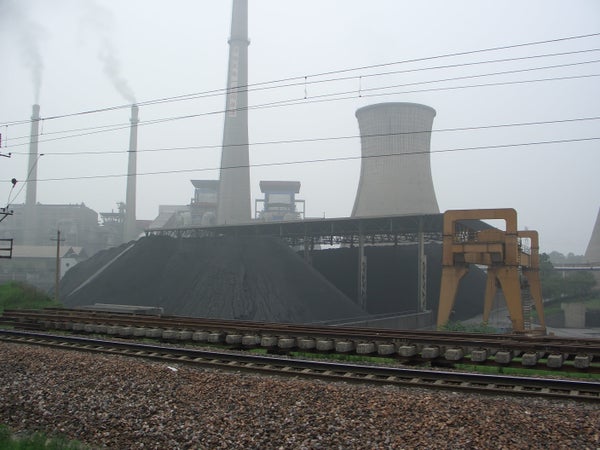This article was published in Scientific American’s former blog network and reflects the views of the author, not necessarily those of Scientific American
China last week released its draft 13th Five-Year Plan (13 FYP) (2016-2020) and Premier Li Keqiang’s Work Report, in which the government reviews the past year’s achievements and lays out its social, economic and political goals that will guide development in the next five years. Included in the 13 FYP and Premier Li’s Work Report are a series of statistics and indicators detailing progress made in the past year and the benchmarks to be met in 2016. Premier Li’s Work Report details China’s remarkable success in meeting or exceeding every environment, energy and climate-related target in the 12th FYP.
Of the many statistics in the Work Report, a lot of media attention has focused on China’s dropping coal consumption numbers, with analysts suggesting that this decline could mean China will reach peak carbon emissions well before its 2030 goal. Last year, when China reported a precipitious 2.9 percent drop in 2014 coal consumption, an amount roughly equal to Venezuela’s 2012 total primary energy consumption, there was skepticism regarding the validity of these numbers, given perenial uncertainty surrounding China’s official energy statistics. A decrease of this magnitude in coal consumption had been unexpected, and China energy experts were quick to point out that a single year’s downturn does not change the fundamental role coal plays in China’s economy, given that nearly 80 percent of China’s electricity is coal-fired.
The belief that China’s reduced coal consumption in 2014 was an anomalous blip has been turned on its head now that 2015 saw an even greater drop, of 3.7 percent, in coal consumption. But does this downward trend in coal consumption translate directly to carbon emissions? Have China’s emissions peaked?
On supporting science journalism
If you're enjoying this article, consider supporting our award-winning journalism by subscribing. By purchasing a subscription you are helping to ensure the future of impactful stories about the discoveries and ideas shaping our world today.
Reduced coal consumption undoubtedly means lower carbon emissions from the energy sector. Greenpeace reported in 2014 and 2015 China’s carbon emissions decreased by 0.8 and 2.3 percent, respectively. And the International Energy Agency (IEA) confirmed last week that global energy-related emissions have remained steady for the last two years - the first time this has occurred during a period of economic growth in four decades - in part due to China’s drop in coal consumption. Some analysts (here and here) are claiming that drops in coal-based carbon emissions indicate that carbon emissions have indeed peaked.
Not so fast: Says China’s government
In its usual mode of “under-promising and over-delivering,” China’s leadership insists that carbon emissions have not yet peaked. After all, energy is a large - but not the only - contributor to carbon emissions. China’s urbanization goals, which would have 60 percent of the nation’s people living in cities by 2020, could lead to emissions increases of as much as 25 percent. Simple back-of-the-envelope calculations using China’s official statistics and Premier Li’s Work Report confirm the Chinese government’s stance (Figure 1). From Premier Li’s Work report, GDP increased 6.9 percent and carbon intensity (CO2 emissions per unit GDP) decreased 6 percent from 2014 to 2015. A simple calculation shows during the 12th Five-Year Plan that CO2 emissions grew at a rate of 0.486% from 2014 to 2015. While carbon intensity decreased from 2011-2015, carbon emissions grew, albeit at a slower rate.
.png?w=594)
Thanks to urbanization and industrialization, carbon emissions have continued to grow even as emissions per unit of GDP have dropped. Credit: the authors
Chinese government officials stand firm in saying that China’s carbon emissions have not peaked, emphasizing the country is still industrializing. Experts contend that China’s emissions can peak well before 2030, most likely before 2025, yet estimates depend heavily on GDP growth rate assumptions. Official carbon emission and peak-year estimates depend on assumptions regarding China’s GDP growth rates, but, in Premier Li Keqiang’s own words, these figures are often “man-made.” Government statistics show that China has in recent years grown its economy by building out low-carbon service sectors, yet Beijing insiders claim that the actual economic picture is in reality not so rosy. Many economists believe that China’s official GDP growth rates are overstated, suggesting that the leveling off of the nation’s emissions is a result more of the economic slow-down than any other factor. The economic headwinds have also had social repurcussions. Massive layoffs are planned for 15 percent (1.8 million) of China’s coal and steel workforce. This move to reduce overcapacity comes with a 100 billion RMB pricetag for worker relocation.
Coal bust = environmental boon?
What does the energy consumption drop-off mean for the environment? An economic slowdown would be bad for China, yet it may lead to a cleaner environment, right? We wouldn’t bet on it. As demand for fossil power drops, so do prices. Given low-carbon fuels’ additional cost, when a renewable push comes to a fossil shove, expect countries to choose the cheaper option. Russia’s recent history provides an example of this energy consumption rebound, as that country’s emissions peaked at 3.5 GtCO2e before the collapse of the USSR then sunk to a low of 2 GtCO2e after. The nation has since steadily increased its emissions. Indeed, Russia has an inadequate plan to reduce GHG emissions according to Climate Action Tracker, and it is projected to increase emissions through 2030.
Analysts are divided into the usual bull and bear camps in their views of China’s economic prospects. Environmentalists tend to view economic growth as synonymous with environmental degradation. But this thinking is perhaps an oversimplification, as it focuses only on short-term tradeoffs. For China to remain at the international climate negotiating table, it will need adequate growth and stability to ensure the Party’s existence. Without that, all bets are off.
